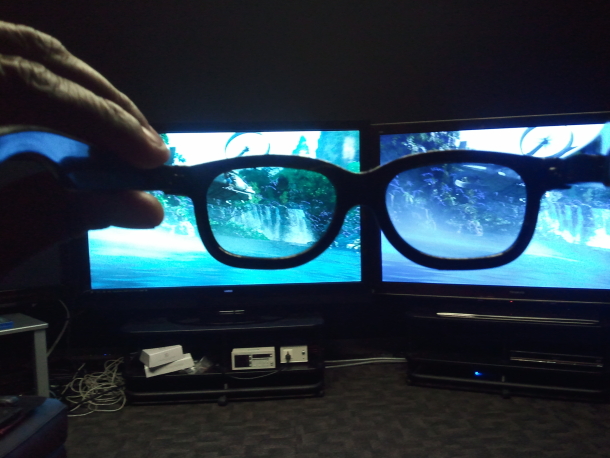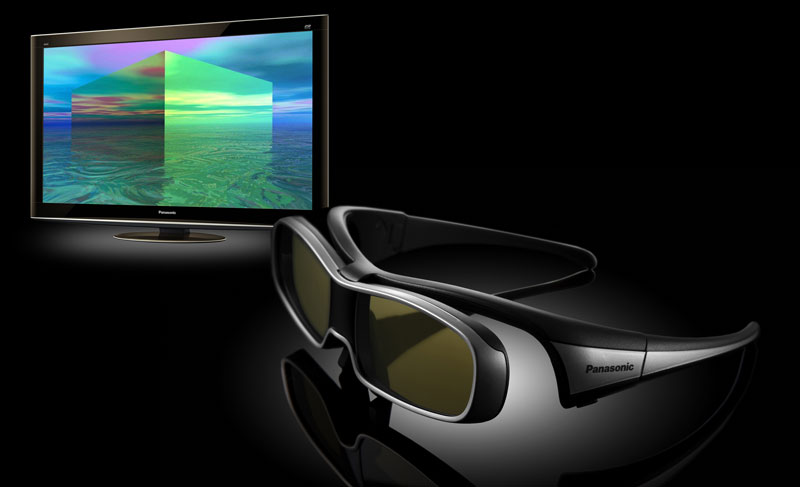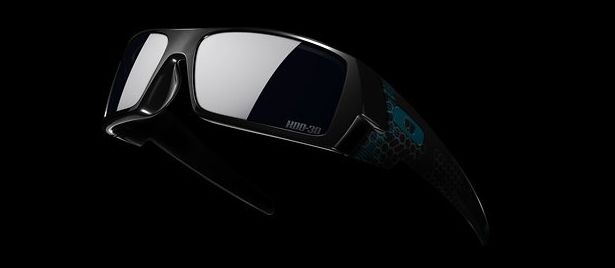The 3D TV War: Which One Should You Buy?

Much confusion has arisen due to the recent ads by LG and others comparing their new 3D TVs to “conventional” 3D sets. Let’s be clear: there is absolutely a war among 3D television manufacturers, and it’s likely to intensify as more appealing 3D content hits the market. So what are the differences between the types of 3D displays, and more importantly, which one is better?
There are presently two types of mass-produced stereoscopic displays: those based on active shutter and those based on passive polarization technology. Both presentations artificially enhance the sense of depth in an image by delivering slightly differing views to each eye. Our brain then fuses the two images together, creating an illusion of depth. Note that all types of 3D content — including 3D Blu-ray, video games, and cable and satellite programs — are compatible with both types of 3D displays. While both formats can effectively convey a three-dimensional image, notable differences exist in how each format is perceived by the end user and in the glasses used for the respective technologies.
Active Shutter 3D
Active shutter-based televisions arrived on the market first, shortly following the massive success of James Cameron’s Avatar. These sets incorporate “shutter” glasses along with an active component, the mechanics of which are relatively simple. The display shows alternating L eye and R eye images in a rapid sequence that is synced to the glasses, which block one eye while leaving the other eye open (hence, its “shutter” designation). The sync between the display and glasses is maintained via either IR or Bluetooth, which also happens to be its biggest shortcoming.
As the 3D effect completely depends on the sync between the (emitter in the) display and the (receiver in the) eyewear, there is the possibility that the system will fail to maintain proper sync. Further, interoperability between other IR and Bluetooth 3D televisions and glasses continues to be a problem and will likely not be remedied until an official standard for 3D glasses is finalized.
Panasonic, Sony, LG, Samsung, and Toshiba produce active shutter displays in both LCD and plasma varieties.
Passive Polarized 3D
Televisions using polarized 3D technology require different eyewear called polarized glasses, which are passive in nature and, in principle, function just like polarized sunglasses. Polarized glasses use offsetting polarization filters in each lens that correspond to the filters applied to the surface of the television screen. As each eye only receives light that is polarized in the corresponding direction from the screen, each eye sees a different image. The biggest downside to this approach is that vertical resolution is halved as a byproduct of polarization. On the upside, any pair of polarized glasses will work with any polarized TV, and they’re much cheaper than active glasses.
LG, Vizio, and Toshiba market passive polarized displays for LCDs only.
So what are the practical differences between these two technologies? Each 3D display type has pros and cons, largely resulting from the glasses required to view the stereoscopic signals. We’ll break down the differences that involve the most salient considerations.
Weight
Most of the cons of shutter glasses can be traced to its active attributes. The receiver, along with the batteries required to power the glasses, add weight. This may grow uncomfortable during the span of a full-length movie and may be of considerable concern for those already wearing prescription glasses. On the other hand, polarized glasses are no heavier than standard sunglasses.
Charge Time
Active shutter glasses come in the non-rechargeable (30 – 80 hours) or rechargeable variety (2 hours). Rechargeable glasses typically top out at two hours, so it’s best to have a backup pair ready to go. Polarized glasses are entirely passive and thus have a theoretically infinite “charge time.”
Cost
Active glasses range from $50 – 250, depending on whether you buy your TV manufacturer’s glasses or 3rd party glasses (all of which vary in performance). Polarized glasses are cheap by comparison; they can be found for as low as $5. Note that polarized glasses are the same ones that are used for 3D movies in the large majority of theaters. If you’re able to make out with a pair, they’ll work just fine with your passive 3D display at home. As market saturation occurs, expect retail prices of active shutter glasses to drop considerably.
The price difference between the televisions themselves is quite small. The polarizer coating applied to passive displays adds significant cost to its production, so don’t expect passive TVs to be bargain-priced relative to its active shutter counterparts.
Picture Quality
While active shutter TVs maintain full picture information in the horizontal and vertical direction, polarized displays reduce vertical resolution by half. This effectively means a 1080p signal will be perceived as 540p per eye from a polarized display, while an active shutter system delivers full 1080p per eye. Depending on how far you are seated from the screen, this may be a noticeable or negligible trait. This is also content-dependent, as sharper content (e.g., CGI and digital animation) tends to look softer on passive displays. Eagle-eyed viewers who are familiar with good and bad image reproduction will likely notice the drop in resolution when comparing the two technologies side by side, and the disparity becomes more appreciable at suboptimal screen size-viewing distance scenarios. Note that the polarization effect does not affect 2D viewing; full 1080p is maintained in 2D mode.
Crosstalk
Crosstalk – the imperfect separation between the L/R eye images – occurs when one eye sees parts of an image intended for the other eye. This happens due to limitations or deficiencies existing in the display, the glasses or even in the source itself. If it’s present in the movie’s encoding itself, for example, it will be visible with every pair of glasses. Crosstalk can occur in LCDs if the liquid crystals do not switch quickly enough from bright to dark or vice versa and in plasma panels if the phosphor compounds have an afterglow that lasts too long.
While both display types can exhibit this artifact, generally, higher quality displays and glasses will mitigate crosstalk that is otherwise not present in the source. For active shutter implementations, plasma has been shown to exhibit less crosstalk than LCD.
Viewing Angles
While both active and passive possess wide horizontal viewing angles—meaning you and all your friends on the couch can see a coherent 3D image—only active boasts equally accommodating vertical viewing angles. All this means is that if you choose passive, you must ensure the television screen is angled toward your head. If mounting your screen, ensure it’s tilted down toward the viewing positions. Otherwise, the image will break apart and your friends will go home. Keep in mind that fairly marked differences exist among glasses. Crosstalk and brightness can vary along with horizontal viewing angles depending on which glasses you use.
Light Attenuation
The eyewear associated with both technologies reduces light output significantly. Total light loss is as much a function of the display technology as the specific glasses used; each combination of television and glasses is unique. Some 3D displays will auto-adjust brightness when engaging 3D mode. Thus, there is no clear winner here. If you notice the image is too dim when slipping on the glasses, you should boost the brightness on your television. Optimally, you’d have separate settings for 3D and 2D viewing to avoid constantly manipulating your display settings.
Those are the facts. Polarized 3D is lighter, thinner, cheaper and less error-prone, but cuts resolution in half. Active 3D preserves full picture detail, resulting in an overall higher quality 3D picture, but can have syncing and interoperability issues. If you’re a plasma fan, then active shutter is your only choice at this time. Remember, all 3D TVs can also be used to view standard 2D material. But in case you decide to watch some 3D content down the road, be sure to choose the technology that best suits your viewing environment, preferences and budget.
For those who would like even more in-depth information, Raymond Soneira has a top-rate feature at 3D TV Display Technology Shoot-Out.
Who has a 3D TV and what type? For potential buyers, which type more appeals to you?
Feature image via Cnet





Comments